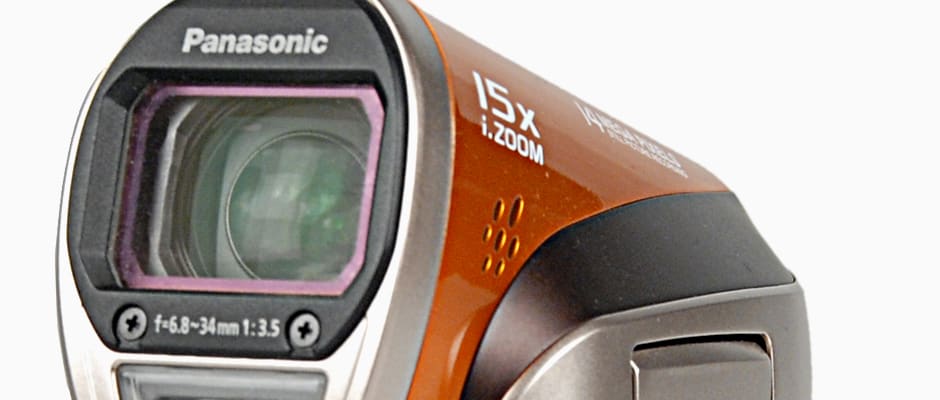Pros
Cons
Introduction
The Panasonic HX-WA2, which is waterproof up to 10 feet, is available in orange or blue, and has an MSRP of $279.
Video Review
{{section_header}}{{section.name}}{{/section_header}}
Design
It takes just one look at the HX-WA2 for you to immediately recognize that this is no ordinary camcorder. Its pistol-grip design has been used before on consumer models—mainly by the Sanyo company, which was acquired by Panasonic a few years ago. Since that acquisition, Panasonic has forged ahead with its own, very similar, line of pistol-grip camcorders of which the HX-WA2 is part. It is strange and unusual, but it also has its benefits. We found the WA2 was easier to keep steady in the hand, and, while the buttons and body design don't feel all that great, the shape of the camcorder made for a very good grip.
Front
{{section_header}}{{section.name}}{{/section_header}}

Back
{{section_header}}{{section.name}}{{/section_header}}

Left
{{section_header}}{{section.name}}{{/section_header}}
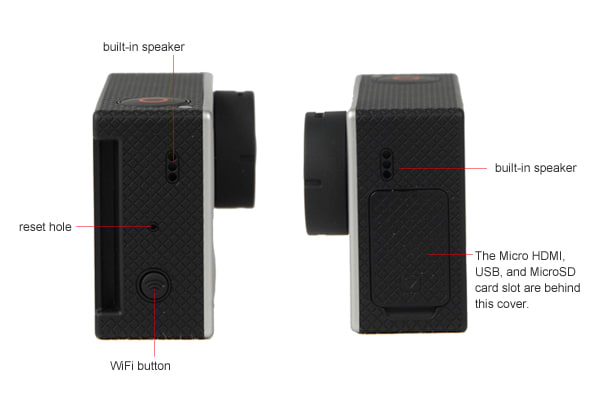
Right
{{section_header}}{{section.name}}{{/section_header}}
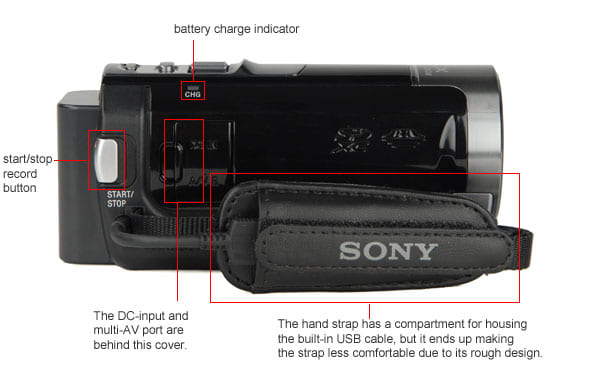
Top
{{section_header}}{{section.name}}{{/section_header}}

Bottom
{{section_header}}{{section.name}}{{/section_header}}

In the Box
{{section_header}}{{section.name}}{{/section_header}}

The Panasonic HX-WA2 comes with the following accessories:
• AV cable
• wrist strap
• Micro USB cable
• AC adapter
• instruction manual
• cleaning brush
• rechargeable battery pack
Performance
The HX-WA2's highs came in our low light tests, where the camcorder did very well limiting noise and producing accurate colors without much illumination. The camcorder also did well in our motion test, which was surprising, as the WA2 was not very good in our sharpness test. Overall, this is a decent budget model in terms of performance, but there are other ultracompact camcorders—mainly the Samsung HMX-W200—that matched it point for point in our tests.
Color
{{section_header}}{{section.name}}{{/section_header}}
Compared to your average mid-range camcorder, the HX-WA2 did not do well in our color test. Compared to its direct competition of camcorders falling under $300, however, the WA2 was one of the top performers in this test. Its colors were deep and strong, with a 97% saturation level, and it recorded an error score of 5.04. If you look at the score chart below, this color error number is better than the models we compared to the WA2 (although the Samsung HMX-W200 came in right behind). Most good mid-range or high-end camcorders have much better color error numbers, usually coming in around or below 3.5. More on how we test color.
Panasonic loaded the WA2 with a surprising amount of color modes for a little waterproof camcorder. You can see examples of these color modes in our still life images below. The modes don't alter the look or color of your videos a huge amount, but they will give everything a subtle change. Also, there's no way to manually adjust the intensity of the color controls—you just have the option of using one of them or shooting in normal mode.
One thing that really bugged us is that some of the color modes only work in photo mode (specifically the HDR Paint option). Panasonic doesn't let you know this is the case, so using the mode won't yield any special results in video mode when the option is engaged.
Like we said, the WA2 may not have colors as accurate as what you see on top camcorders, but for a little waterproof model it did very well in this test. We like the rich, vibrant tones captured by the camcorder, and we like the simple color modes that Panasonic includes on the model. All you have to do is compare the WA2 to the ultra-yellow Kodak Zx5 and Panasonic TA20 in order to see how much better the HX-WA2 was in this test.
{{comparison_bars title="Color Score Comparison", attribute="Color Score", xLabel="Color Score"}}
Low Light Color
{{section_header}}{{section.name}}{{/section_header}}
Just like we saw in bright light, the HX-WA2 was near the top of its class in terms of color accuracy in low light. Sure, its final number (5.01 color error) was a bit worse than the Samsung HMX-W200 and Panasonic HM-TA20, but the discrepancy was negligible. We were impressed by the camcorder's strong color saturation retention in low light as well. More on how we test low light color.
We did run our color test using the WA2's 30p frame rate as well, but the results weren't any better or prettier than its low light color performance using a 60i frame rate. In fact, the color error got a bit worse and the saturation level dropped a lot with the 30p mode. We don't usually say this, but our recommendation is to stick with the 60i mode with the HX-WA2 in low light situations. Lots of camcorders do better in low light with 30p or 24p frame rates, but not this one.
Noise
{{section_header}}{{section.name}}{{/section_header}}
Noise levels were low to the point of non-existent on the HX-WA2's bright light test—a great showing for the little camcorder. The WA2's 0.45% noise level in this test is on par with what we usually see from mid-range and high-end models. It's also less noise than we saw on any of the models we compared it to in this review. More on how we test noise.
Here's a hidden tip that only our seasoned readers may know about: the noise comparison crops shown above offer a tremendous amount of insight into how sharp of a video image the camcorder is capable of recording. For the HX-WA2 this crop looks decently sharp, but... wait, what's wrong with that horizontal trumpet? It looks all jagged and choppy. That's not right. Something is clearly wrong with the WA2—perhaps Panasonic is oversharpening the image too much? Jump over to our motion and sharpness section for more details about this very noticeable issue.
{{comparison_bars title="Noise Score Comparison", attribute="Noise Score", xLabel="Noise Score"}}
Low Light Sensitivity
{{section_header}}{{section.name}}{{/section_header}}
The HX-WA2 is able to record a usable video image without the aid of much light. In our tests, we found the camcorder needed just 9 lux of light to hit 50 IRE on our waveform monitor, which is a good score for a consumer camcorder. Of course, the HX-WA2 does get a boost from its use of a slow shutter speed in low light situations—a feature we will turn off if the camcorder allows—but that's an "advantage" that most ultracompact models gain in this test. More on how we test low light sensitivity.
Even though its numbers were good in this test, the WA2 was actually a bit behind the competition in low light sensitivity. The other camcorders we compared it to all needed five lux or less to reach the same levels that the WA2 needed nine lux fore. Still, the HX-WA2's results are positive.
Interestingly, we noticed the camcorder didn't offer an improvement in sensitivity when we used its 30p record mode as compared to its 60i setting. More surprising was the fact that the WA2 showed little increase in sensitivity when we tested without using optical zoom on the camcorder. Usually we notice a big increase in sensitivity with the camcorder's lens set to its wide zoom level (which, in turn, allows the camcorder to use its widest aperture). With the WA2 this was not the case. In a way, this bodes well for the little camcorder, as no matter how you shoot your video, you'll always need the same amount of light to record a viable image.
{{comparison_bars title="Low Light Sensitivity Comparison", attribute="Low Light Sensitivity Score", xLabel="Low Light Sensitivity Score"}}
Low Light Noise
{{section_header}}{{section.name}}{{/section_header}}
The WA2 did a great job in our bright light noise test, but the camcorder did an even better job—compared to the competition at least—in our low light test. Using its regular 60i frame rate, the HX-WA2 averaged just 0.44% noise, which is a very low amount (for any type of camcorder). More on how we test low light noise.
The Panasonic HX-WA2 lets you record Full HD video using a 60i or 30p frame rate. While we often see an improvement in low light performance when using a 30p frame rate, we didn't see a lower noise percentage (or color accuracy) for the WA2 when we shot 30p video. In fact, the noise level rose by about 0.2% in 30p mode compared to 60i.
{{comparison_bars title="Low Light Noise Score Comparison", attribute="Low Light Noise Score", xLabel="Low Light Noise Score"}}
Low Light Color
{{section_header}}{{section.name}}{{/section_header}}
Just like we saw in bright light, the HX-WA2 was near the top of its class in terms of color accuracy in low light. Sure, its final number (5.01 color error) was a bit worse than the Samsung HMX-W200 and Panasonic HM-TA20, but the discrepancy was negligible. We were impressed by the camcorder's strong color saturation retention in low light as well. More on how we test low light color.
We did run our color test using the WA2's 30p frame rate as well, but the results weren't any better or prettier than its low light color performance using a 60i frame rate. In fact, the color error got a bit worse and the saturation level dropped a lot with the 30p mode. We don't usually say this, but our recommendation is to stick with the 60i mode with the HX-WA2 in low light situations. Lots of camcorders do better in low light with 30p or 24p frame rates, but not this one.
Motion
{{section_header}}{{section.name}}{{/section_header}}
We didn't expect the HX-WA2 to render motion very well, but the camcorder surprised us. Motion looked fairly smooth and artifacting wasn't much of a problem in our test. There was some trailing, blur, and we noticed straight lines had a bit of a wobble, particularly in the rotating pinwheel portion of our test. We didn't see the ragged lines that we saw in the clips of our color test chart, however, so we're unsure as to why the WA2 produced that issue in the unmoving shots of our charts.
Overall, this is a surprisingly good camcorder for recording motion. It comes with multiple frame rate options (60i and 30p in Full HD and a 720/60p mode as well), and it handles artifacting better than a good chunk of the competition. More on how we test motion.
Video Sharpness
{{section_header}}{{section.name}}{{/section_header}}
The Panasonic HX-WA2 did worse on our sharpness test than all the models we compared it to, although its numbers were very similar to Panasonic's previous HM-TA20 waterproof model. The WA2 registered a horizontal sharpness of 575 lw/ph and a vertical sharpness of 500 lw/ph, neither of which are all that impressive. It looks like loading the image sensor with tons of pixels didn't help give the HX-WA2 a boost in terms of sharpness.
One thing to note, the camcorder did a whole lot better with sharpness when we shot perfectly still videos with no motion. Our sharpness test is performed by panning back and forth very slowly, and that's when we noticed the steep drop in overall sharpness. For still shots, the sharpness levels were a good 100 - 150 lw/ph better than what we saw in our panning test. More on how we test video sharpness.
{{comparison_bars title="Video Sharpness Score Comparison", attribute="Video Sharpness Score", xLabel="Video Sharpness Score"}}
Stabilization
{{section_header}}{{section.name}}{{/section_header}}
The WA2 is equipped with two levels of electronic image stabilization: regular EIS and Active Mode. We tried both IS settings in our stabilization test, and, surprisingly, we found neither mode helped reduce the shakiness of the video image. In fact, the Active Mode made things a tiny bit shakier (although not by much). What does this say about the WA2? It says that its EIS system is bogus and doesn't work very well. More on how we test stabilization.
Maybe we should have seen this coming. Older Sanyo camcorders, which are the HX-WA2's true ancestors, also performed terribly in this test. Most Panasonic camcorders, however, do extremely well with stabilization—although Panasonic includes optical image stabilization on its regular camcorders. The HX-WA2 is kind of the odd man out for Panasonic, as it is one of the few models in the company's lineup that uses EIS instead of OIS. And it is clear that Panasonic is far better at making an optical stabilization system than an electronic one.
We should note that the HX-WA2 does have a photo stabilization setting as well as video stabilization. We did not test this still image EIS system, so we cannot attest to how well it performs when taking photos.
Testing Samples
{{section_header}}{{section.name}}{{/section_header}} Panasonic HX-WA2 Motion Test 60i
Real World Samples
Bright Daylight Sample
Underwater Sample
Indoor Low Light Sample
Usability
A number of problems floated to the surface when we used the Panasonic HX-WA2. Simply put, this isn't the best designed camcorder in the world, and, even compared to other budget waterproof models, it feels clunky and cheap. The buttons don't offer much give, the menus are bland, and the controls aren't easy to adjust. Yes, the WA2 has far more features than your average camcorder in this price range, but you should be certain that you're going to want access to all these features before you spring for the WA2. Sometimes simpler is better with budget camcorders—take in point the Samsung W200 and Kodak PlaySport Zx5, which are two of our favorite waterproof models.
Auto Mode
{{section_header}}{{section.name}}{{/section_header}}
Just like most Panasonic camcorders, the HX-WA2 has a dedicated auto mode, which is engaged by pressing the iA (Intelligent Auto) button on the inside of the LCD cavity. The auto mode is capable of working well, but we noticed a few bumps in the road. Focus wasn't always quick to adjust, but the camcorder does allow you to focus on subjects just a millimeters away from the lens without having to switch over to macro mode (as long as you don't use any zoom). We found the focus "popped" at times when we shot moving subjects, as the camcorder struggled to maintain focus on the area of the frame we wanted.
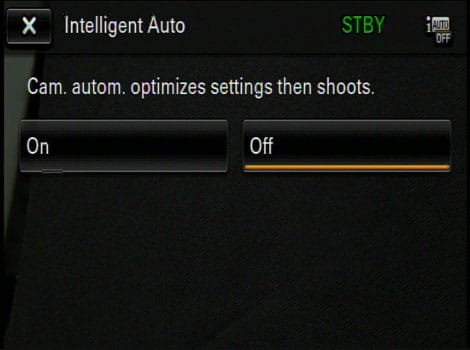
The iAuto mode button is difficult to find, but when you do find it the option for turning on the mode looks like this.
Auto Controls
{{section_header}}{{section.name}}{{/section_header}}
Most ultracompact camcorders have fixed lens systems that don't use any kind of autofocus, so, based on that, the WA2 offers more in the way of focus flexibility than the competition. But it also makes for a more confusing camcorder. People who are accustomed to shooting with fixed lens devices may not appreciate the slow autofocus on the WA2. Auto exposure on the camcorder was generally decent, but we though the camcorder overexposed a bit under bright, outdoor light. It also didn't do very well with mixed lighting—especially when we shot outdoors in areas with lots of shadows and some bright patches.
Other Auto Features
{{section_header}}{{section.name}}{{/section_header}}
The WA2 has plenty of scene modes, multiple auto exposure metering options, a few color modes, and a face detection feature that is called "face chaser." Again, we're not used to seeing this many special auto controls on a camcorder in the WA2's price range, but it is clear that the WA2 isn't your average waterproof ultracompact. It's got more to offer—and that's precisely why it isn't quite as simple or easy to use as the competition.
Menus
{{section_header}}{{section.name}}{{/section_header}}
The menus on the WA2 look are bland and boring—just like those seen on previous Sanyo Xacti camcorders. This makes sense, as Panasonic acquired Sanyo a few years back. So, in all likelihood the HX-WA2 is a Sanyo Xacti camcorder with its labels changed to read "Panasonic". The HX-WA2 has some of the same handling quirks we saw from Sanyo camcorders, including the confusing "shortcut" menu that offers hidden features found nowhere else in the menu system. This is a more complicated and complex camcorder than it should be, and there is no reason a budget camcorder like the WA2 should have a 200+ page instruction manual.
Handling
{{section_header}}{{section.name}}{{/section_header}}
Before we bash the Panasonic HX-WA2 for how poorly it handles—and let's be clear, the camcorder has some serious flaws—let's take a moment to talk about the benefit of a pistol grip design. Sure, it looks a little strange, and it feels like you're holding a hose nozzle or a Star Trek phaser gun knock-off. But this upright design lets you grip the camcorder quite well, and it does so without the need of a hand-strap. We also find this method of gripping the camcorder makes it easier to keep the product steady in certain shooting situations.

Ok. That's it. Now we need to address the WA2's glaring design flaws. For starters, this is a product (like many in the budget category) that feels incredibly cheap, and that's not something you want to see from a waterproof model. The buttons are absolutely terrible, particularly the cramped zoom buttons that are sandwiched between two large control buttons—the flimsy photo shutter button and the start/stop video. The tiny zoom range button above the zoom toggle may be the worst button on the entire camcorder, as it offers zero haptic feedback whatsoever.

The joystick interface, which is used to navigate menus and manipulate controls, isn't the worst we've seen, but it's not very good. We like that you can control the functions by using a single finger (actually the thumb works best), but the joystick's tiny size and cheap design don't make it a good for adjusting precise controls like focus. We also were bothered by the position of the WA2's menu button on the left side of the camcorder. This is a button that requires either a second hand or some very tricky finger work to press. We kept wishing a menu button would pop up on the back of the camera somewhere, ideally in a position accessible with our thumb.


These dedicated buttons give you quick access to aperture and shutter speed controls.
Portability
{{section_header}}{{section.name}}{{/section_header}}
It may not be fair to classify the HX-WA2 as an "ultracompact" camcorder, but it is still small enough to slip and out of a large pocket with ease. The flip-out LCD and waterproof casing definitely add to the camcorder's bulk, as does the 5x optical zoom lens that is far more extensive than the tiny lenses usually associated with ultracompact models.
LCD
{{section_header}}{{section.name}}{{/section_header}}
Measuring 2.6-inches diagonally, the HX-WA2's LCD is bigger than most screens on waterproof camcorders—but is still smaller than some as well (like the 3-inch touchscreen on the Panasonic TA20). The real advantage provided by the WA2's screen is its articulated design that allows it to tilt, twist, and turn up to 285 degrees for added flexibility. This really helps to eliminate glare or if you want to do some "self" recording by pointing the camcorder at your own face. Most waterproof ultracompact camcorders do not have articulated screens, so this is something unique to the WA2 (and the many Sanyo camcorders that came before it).
Stabilization
{{section_header}}{{section.name}}{{/section_header}}
The WA2 is equipped with two levels of electronic image stabilization: regular EIS and Active Mode. We tried both IS settings in our stabilization test, and, surprisingly, we found neither mode helped reduce the shakiness of the video image. In fact, the Active Mode made things a tiny bit shakier (although not by much). What does this say about the WA2? It says that its EIS system is bogus and doesn't work very well. More on how we test stabilization.
Maybe we should have seen this coming. Older Sanyo camcorders, which are the HX-WA2's true ancestors, also performed terribly in this test. Most Panasonic camcorders, however, do extremely well with stabilization—although Panasonic includes optical image stabilization on its regular camcorders. The HX-WA2 is kind of the odd man out for Panasonic, as it is one of the few models in the company's lineup that uses EIS instead of OIS. And it is clear that Panasonic is far better at making an optical stabilization system than an electronic one.
We should note that the HX-WA2 does have a photo stabilization setting as well as video stabilization. We did not test this still image EIS system, so we cannot attest to how well it performs when taking photos.
Manual Focus
{{section_header}}{{section.name}}{{/section_header}}
The WA2 does have the ability to adjust focus manually, but the system for doing so is not very good. You must use the rear-mounted joystick to click back and forth to adjust the focus plane—it's not pretty and it doesn't give you very precise control. We don't recommend using it, unless you're trying to get a specific focus on an unmoving subject. If you have to change focus on the fly, you won't be happy.
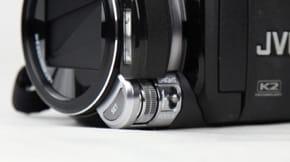
The adjustment dial makes accurate focus adjustments easy.
Manual Exposure
{{section_header}}{{section.name}}{{/section_header}}
You can't set aperture or shutter speed on the WA2, but you can set basic exposure. Finding the exposure adjustment option on the WA2 is a challenge, and the only reason we knew where to look is because we are familiar with the old Sanyo Xacti models that the HX-WA2 is based on. Exposure control isn't in the menu. You have to program a customized "shortcut" menu in order to use the feature. That's the only way you can adjust exposure. Stupid? Yes. We were hoping this was the kind of thing Panasonic would do better when it took over Sanyo's Xacti line. Apparently we were wrong.
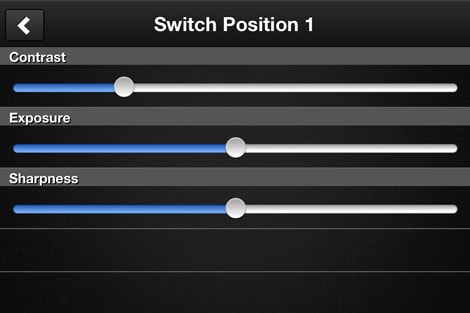
The manual exposure controls are only found on the Contour app, not on the camcorder itself.
Miscellaneous Controls
{{section_header}}{{section.name}}{{/section_header}}
The Panasonic WA2 offers ISO control in both video and photo mode. In video mode this ISO function works just like gain control, except it is displayed in normal ISO intervals. Adjusting ISO will boost or lower the brightness of your image, or you can set ISO to auto and let the camcorder do the work. The ISO range on the WA2 goes from ISO 50 to ISO 1600.
Auto Controls
{{section_header}}{{section.name}}{{/section_header}}
Most ultracompact camcorders have fixed lens systems that don't use any kind of autofocus, so, based on that, the WA2 offers more in the way of focus flexibility than the competition. But it also makes for a more confusing camcorder. People who are accustomed to shooting with fixed lens devices may not appreciate the slow autofocus on the WA2. Auto exposure on the camcorder was generally decent, but we though the camcorder overexposed a bit under bright, outdoor light. It also didn't do very well with mixed lighting—especially when we shot outdoors in areas with lots of shadows and some bright patches.
Audio Controls
{{section_header}}{{section.name}}{{/section_header}}
Want lots of audio features on your compact camcorder? Then you should look elsewhere. The HX-WA2 has a built-in stereo mic and a wind cut feature, but that's all. No audio level adjustment options, no mic or headphone jack, nothing. Of course, limited audio features is par for the course with waterproof camcorders. Who needs audio when you're recording underwater?
Features
The HX-WA2 has a lot of controls for a little waterproof camcorder, but if you're a die-hard fan of manual controls and settings, you're still likely to be disappointed. There's no control over aperture or shutter speed, but you can set ISO, white balance, and the menu has a number of special functions as well. The WA2 really stands out in terms of recording options and still image modes—the camcorder is simply full of them. If that's something that interests you, then the HX-WA2 has a very good chance of being your friend.
Compression
{{section_header}}{{section.name}}{{/section_header}}
If you're new to camcorders, you probably don't know much about "compression" or "codecs" or video recording modes. If you want to know more, just click on the link at the end of this paragraph. For those that do know their stuff, here's how the WA2 records video. The camcorder uses an MPEG-4 codec to compress HD video (as well as multiple lower-res recording options). The WA2 does not use AVCHD compression, which is the system found on higher-end camcorders—as well as most Panasonic camcorders (other than its ultracompact lineup). The MPEG-4 clips recorded by the HX-WA2 can easily be "dragged and dropped" from a memory card directly to your computer's media player without the need to process or render the clips with any special software (something AVCHD requires). Read more about the advantages and disadvantages of various high definition compression types.
Media
{{section_header}}{{section.name}}{{/section_header}}
You may have read the HX-WA2 comes with a tiny bit of internal flash memory. We urge you to forget about this internal memory, as the amount (64MB) is so small that it is only good for storing a few seconds of video or a handful of photos. If your plan is to rely on this meager 64MB of internal memory, you're going to quickly be stuck without any room to store your content. Here's a better idea: buy an SD-type memory card (SDHC or SDXC will work too) and use that with the camcorder instead. The card slot is located right next to the battery compartment and is protected by the locking waterproof port cover. Read more about the advantages and disadvantages of various media types.

Resolution & Frame Rates
{{section_header}}{{section.name}}{{/section_header}}
The HX-WA2 offers 60i and 30p frame rates at a variety of different video resolutions. You can record 1920 x 1080 Full HD video, 1280 x 720 HD video, 960 x 540 iFrame recording (designed for easy editing with Apple's iMovie), or 640 x 480 standard definition recording. There's also a voice record mode if you don't want to record video at all (just audio).
Still Features
{{section_header}}{{section.name}}{{/section_header}}
If you thought the WA2's video recording options were extensive, then you're ready for an even bigger surprise here. The camcorder is loaded with nine different photo size options, ranging from a large of 4352 x 3264 to a small of 640 x 480 for its still images. You can take photos with a 4:3 (five options) or 16:9 (four options) aspect ratios, and there are four different burst modes and two different panorama modes on the camcorder (360° or 180°). Two of the burst modes are what Panasonic calls "reverse burst", which means they continually take photos while you hold down the shutter button, then saves the maximum number of photos possible going backwards from the release of the shutter button.
We're not done. The WA2 also has a built-in flash, two self-timers, ISO control, and a photo image stabilization setting. Yes, this is a ton of features, and recounting them all makes us think Panasonic spent just as much time crafting the HX-WA2 as a camera as it did a camcorder.
Lens & Imaging System
{{section_header}}{{section.name}}{{/section_header}}

The Panasonic HX-WA2 is larger and heavier than most "ultracompact camcorders", but its added bulk does provide some advantages. For instance, the camcorder is outfitted with a 5x optical zoom lens—while most of the waterproof camcorder competition have no optical zoom capabilities. On the outside of the camcorder you may notice some text that says "15x", which refers to the WA2's intelligent zoom capability (a feature that enhances the zoom capability without degrading image quality). We should also warn you about another bit of confusion: when you use the zoom on the WA2, the zoom bar display on the LCD shows a scale ranging from 1x to 6x zoom. Why does it say 6x instead of 5x here? We have no idea, as all of Panasonic's literature explains the WA2 has a 5x optical zoom maximum. This is just one example of Panasonic's shoddy oversight and poor quality control with the HX-WA2.
The sensor on the WA2 is large and loaded with pixels. It's a CMOS chip that measures 1/2.33-inches diagonally and is stuffed with over 14 megapixels. Yes, that means the WA2 can take up to 14 megapixel photos, which is high-res for a camcorder or camera in this price range, but just because the images are large doesn't mean they're going to look great. The quality of the lens, sensor, and processor have more to do with image performance than the pixel count.
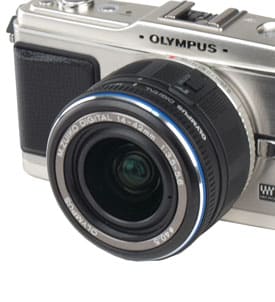
LCD
{{section_header}}{{section.name}}{{/section_header}}
Measuring 2.6-inches diagonally, the HX-WA2's LCD is bigger than most screens on waterproof camcorders—but is still smaller than some as well (like the 3-inch touchscreen on the Panasonic TA20). The real advantage provided by the WA2's screen is its articulated design that allows it to tilt, twist, and turn up to 285 degrees for added flexibility. This really helps to eliminate glare or if you want to do some "self" recording by pointing the camcorder at your own face. Most waterproof ultracompact camcorders do not have articulated screens, so this is something unique to the WA2 (and the many Sanyo camcorders that came before it).
Connectivity
{{section_header}}{{section.name}}{{/section_header}}
The HX-WA2 is a waterproof camcorder, so all of its ports need to be protected well from contact with water. To make this easier, Panasonic included just two little ports on the WA2, and both of them are located behind the single waterproof port cover on the back of the camcorder. This cover has an opening switch and a locking mechanism for extra waterproof security.
Opening the port cover, you'll first see the back of the cover is lined with a rubbery material that is meant to keep water out of these region. Panasonic also ships a small brush with the WA2 that is helpful for getting sand or debris away out of this area after using the WA2 in a lake or ocean. The two ports located in this area are a micro HDMI terminal and a micro USB port. The micro USB port is special—it works with the provided AV cable for connecting to a TV, and it is used to charge the camcorder's battery (as well as connect to a computer).
One last thing, the WA2 comes with an AC adapter that has a USB input at one end and a two-prong wall plug at the other. This gives you some flexibility as to how you can charge the WA2 (either by connecting to a computer via USB, or by using this adapter and connecting to a regular power outlet).
Battery
{{section_header}}{{section.name}}{{/section_header}}
The battery itself on the HX-WA2 isn't anything special. It's slim, rectangular, and fits into a small slot inside the camcorder's port compartment (to protect it from water). It's about the size of a cell phone battery and it locks into place with a small plastic clip. Since the battery must fit into this enclosed compartment, there's no option for using a larger battery pack with the WA2—the provided battery is the only option.
Charging the battery can be done in two ways, and both require the use of a micro USB cable (one is provided with the camcorder). You can connect the cable to a powered computer and charge the camcorder that way, or you can use the AC adapter (provided with the camcorder) to plug the USB cable into a wall outlet. The advantage of using the AC adapter is that you can actually use the camcorder when the cable is plugged in this way (you can even remove the battery pack and use the camcorder this way). This does mean you must have the port cover open, however, which makes the WA2 extremely awkward to hold.

Media
{{section_header}}{{section.name}}{{/section_header}}
You may have read the HX-WA2 comes with a tiny bit of internal flash memory. We urge you to forget about this internal memory, as the amount (64MB) is so small that it is only good for storing a few seconds of video or a handful of photos. If your plan is to rely on this meager 64MB of internal memory, you're going to quickly be stuck without any room to store your content. Here's a better idea: buy an SD-type memory card (SDHC or SDXC will work too) and use that with the camcorder instead. The card slot is located right next to the battery compartment and is protected by the locking waterproof port cover. Read more about the advantages and disadvantages of various media types.

Waterproofing & Ruggedization
{{section_header}}{{section.name}}{{/section_header}}
We might be using a bit of hyperbole by calling the WA2 an "adventure cam", as the only adventuresome thing about the camcorder is the fact that it is waterproof. It doesn't have a rugged, durable design, nor does Panasonic label the WA2 as "crush proof", "shock proof", or "cold proof"—traits that most of the competition proudly display. Certain design elements on the HX-WA2, particularly its articulated LCD, also make the camcorder less suited to "adventure filmmaking" in some ways. Although, having a rotatable LCD does make it easier to record at odd angles (it's just also easier to break than a stationary screen).
We tested the WA2 underwater and found that it did a fine job keeping liquid from entering the important areas of the camcorder. Opening the port cover after submersion, we found a few water droplets, but none had made it past the rubberized barrier that surrounds the battery compartment, memory card slot, and connection terminals. In fact, the WA2 showed less water here than we saw with some of the competition. This camcorder should keep the important components safe when submerged.
The camcorder did, however, retain a lot of water on the body itself. The WA2 is full of nooks, ridges, and holes that, simply put, fill up with water when you take a dive with the camcorder. This makes it a rather difficult model to dry—especially compared to the water repellent Kodak PlaySport camcorders—and we found the camcorder continued to leak liquid long after we brought it up to the surface. It's best to let the WA2 sit on a dry towel or cloth for a few minutes to make sure the camcorder dries completely.
Panasonic does ship a small cleaning brush with the WA2 that may look silly, but does help in removal of debris and liquid from the camcorder (particularly the lens area). We found the brush worked well to remove sand and dirt, which are likely to accumulate if you bring the camcorder to a beach or lake. The brush is tiny, however, so you need to work hard to keep track of it. It's one of those small accessories that most people will lose or forget about after a few days.
{{photo_gallery "Rugged Photos"}}
Kodak PlaySport Zx5 Comparison
We were big fans of the Samsung HMX-W200 waterproof camcorder last year, and we still hold the model in high regard. The Samsung camcorder surprised us with its excellent video sharpness, good low light scores, and easy-to-use design. The camcorder's body didn't feel as good or work as simply as Kodak's line of waterproof camcorders, but its performance was—and still is—the best we've seen from an ultracompact waterproof model overall.
The Panasonic WA2 matched the Samsung in many of our performance tests, although it didn't do nearly as well in sharpness (which may be the most important aspect of image quality). It is also clear that the Panasonic has more features, more settings, and more controls than the Samsung W200 (and any other ultracompact model, for that matter).
The Samsung is an excellent camcorder for someone who is just looking for a simple, "let's go out and shoot video right now", waterproof video experience. The Panasonic is designed for people who don't mind a product that is rough around the edges, and would rather have more options and features to play around with at the expense of simplicity. That's why we'd recommend the Samsung for most people. It's more affordable, it's simpler, and it records good video—the three keys to an excellent budget camcorder.
Panasonic HM-TA20 Comparison
Kodak may not have been doing a lot of things well in the months before it declared bankruptcy earlier this year, but the company certainly made some very good waterproof camcorders. The PlaySport series, which was headed by 2011's Zx5, were some of the finest, cheapest, and simplest ultracompact models on the block—and they "sported" an excellent rugged, waterproof design.
Unfortunately, Kodak won't be making more PlaySports in the near future (or possibly ever again), so here's our immediate recommendation. If you want an affordable, but solid waterproof pocket-camcorder, then go buy a Kodak PlaySport right now. You can find them at sub-$100 dollar prices, which is a bargain for these little camcorders. No, they aren't quite as good performance-wise as the Samsung HMX-W200 or even the Panasonic HX-WA2, but they are very good for simple, basic recording.
The PlaySport also handles well both in and out of the water, and its simple design is more conducive to "adventure" recording than the complex Panasonic WA2. If you don't care about having extensive still image controls, manual focus controls, or optical zoom features—all of which are things the Panasonic WA2 does far better than the competition—then the Kodak PlaySport is a good budget model for you to consider. Just hurry before they're all gone forever.
COMP 3
The HM-TA20 is another waterproof camcorder from Panasonic that debuted last year. Like the WA2, the TA20 did a good job in some of our performance tests, but its difficult handling and terrible touchscreen interface led to our unfavorable review. Ultimately, the TA20 was a forgettable waterproof camcorder, and, with the Samsung W200 and Kodak PlaySport Zx5 coming out in the same year, there wasn't much of a reason to purchase a TA20.
The TA20 and the WA2 differ a lot. The TA20 uses a touchscreen LCD, has a compact rectangular design (like an iPhone), and it has nowhere near the amount of controls and features that you'll find on the WA2. Both camcorders have quirky handling and controls, but we think the WA2 is more likely to have some appeal—especially to feature enthusiasts who want a small camcorder that has lots of options.
The HX-WA2 is a step forward for Panasonic, but it is clear that the company has yet to find the right formula for its ultracompact camcorder line. Every waterproof and ultracompact model Panasonic releases has some promise, but design flaws always make them a bit worse than the competitors.
Conclusion
With its funky design, strange menu, and unique features, the Panasonic HX-WA2 deserves notice. It also deserves to have its story told, and anyone who remembers those Sanyo Xacti camcorders from a few years ago—the VPC-HD2000, VPC-CS1, and the VPC-CG10, for esample—should have a good idea of where the WA2 came from. Panasonic acquired Sanyo in 2010, and, in doing so, the company basically rebranded a bunch of the Xacti models with Panasonic logos... hence the arrival of the HX-WA2.
Sanyo's Xacti line were popular amongst experienced videographers because of their attention to little details. The cams included loads of manual controls, many included mic jacks and accessory shoes, and they had a robust still image capabilities. The WA2 fits this bill on some accounts. It has more features and controls than any other waterproof camcorder on the market, but it also inherited the serious design flaws that plagued those old Sanyo models.
We were hoping Panasonic would be able to polish up the Xacti line, fit the camcorders with a better user interface, and design semi-ultracompact models that would be attractive to a variety of users in the market for a budget camcorder. But the HX-WA2 is ultimately a failure. Yes, it has more controls and features than the competition in the waterproof camcorder market, but it's also bulkier, uglier, and harder to use than its competitors. The HX-WA2, with its flimsy buttons, unattractive menu, and substandard auto controls has nearly as many quirks and frustrations as the Sanyo Xacti camcorders that came before it. Panasonic didn't try hard enough to improve on Sanyo's flaws.
If you are a lover of features and controls, the Panasonic WA2 will probably keep you busy for some time. It's instruction manual is as thick as a novella and its menu is full of options not available on the competition. But if you're looking for a simple waterproof camcorder to take to the beach, we urge you to look elsewhere. The HX-WA2, like the Sanyo camcorders that came before it, is too much of a challenge for a novice videographer to work with.
Photo Gallery
{{photo_gallery "Front Photo", "Left Photo", "Left Open Photo", "Back Photo", "Right Photo", "Top Photo", "Bottom Photo", "Lens Photo", "Lens Photo 2", "3D Lens Photo", "Media Photo", "Easy Mode Photo", "Manual Controls Photo", "Zoom Photo", "Zoom Photo 2", "Ease of Use Photo", "Battery Photo", "LCD Photo 1", "LCD Photo 2", "EVF Photo 1", "EVF Photo 2", "Mic Photo", "Mic Photo 2", "Ports Photo 1", "Ports Photo 2", "Ports Photo 3", "Ports Photo 4", "Ports Photo 5", "Ports Photo 6", "Handling Photo 1", "Handling Photo 2", "Handling Photo 3", "Handling Photo 4", "Box Photo"}}
Meet the tester
Jeremy is the video expert of our imaging team and Reviewed.com's head of video production. Originally from Pennsylvania and upstate NY, he graduated from Bard college with a degree in film and electronic media. He has been living and working in New England since 2005.
Checking our work.
Our team is here to help you buy the best stuff and love what you own. Our writers, editors, and experts obsess over the products we cover to make sure you're confident and satisfied. Have a different opinion about something we recommend? Email us and we'll compare notes.
Shoot us an email